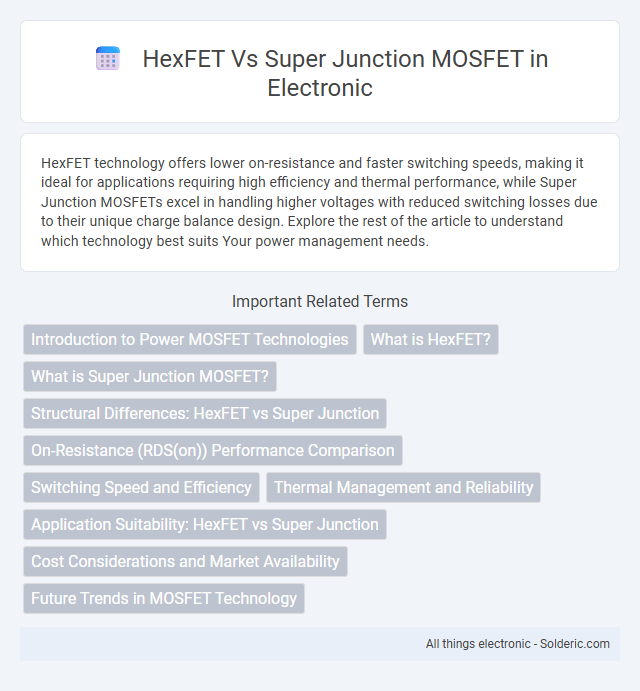HexFET technology offers lower on-resistance and faster switching speeds, making it ideal for applications requiring high efficiency and thermal performance, while Super Junction MOSFETs excel in handling higher voltages with reduced switching losses due to their unique charge balance design. Explore the rest of the article to understand which technology best suits Your power management needs.
Comparison Table
| Feature | HexFET MOSFET | Super Junction MOSFET |
|---|---|---|
| Technology | Planar MOSFET with trench or surface gate design | Alternating p-n columns in drift region to reduce resistance |
| On-Resistance (RDS(on)) | Moderate, higher than Super Junction MOSFETs | Very low, optimized for efficiency |
| Voltage Rating | Typically up to 100V - 250V | Can handle higher voltages, often 400V to 900V+ |
| Switching Speed | Fast switching, suitable for high frequency | Faster switching, lower gate charge |
| Applications | Low voltage power supplies, motor drives | High voltage power supplies, PFC circuits, automotive |
| Cost | Generally lower cost | Higher cost due to complex fabrication |
| Thermal Performance | Good thermal conductivity | Enhanced thermal performance due to lower losses |
Introduction to Power MOSFET Technologies
Power MOSFET technologies such as HexFET and Super Junction MOSFET play crucial roles in efficient power switching applications. HexFET technology utilizes a trench gate structure to provide low on-resistance (R_DS(on)) and high switching speed, making it ideal for high-frequency operations. In contrast, Super Junction MOSFETs implement a multi-layered drift region design that significantly reduces conduction losses and improves breakdown voltage, optimizing performance in high-voltage, high-efficiency power converters.
What is HexFET?
HexFET is a trademarked MOSFET technology developed by International Rectifier, designed to offer low on-resistance and fast switching performance by utilizing a hexagonal cell structure that optimizes current flow and reduces conduction losses. This technology is commonly used in power management applications, enabling higher efficiency and thermal stability compared to conventional MOSFETs. Your choice between HexFET and Super junction MOSFET depends on the specific requirements such as switching speed, conduction losses, and application voltage levels.
What is Super Junction MOSFET?
Super Junction MOSFET is a power semiconductor device designed with alternating p-type and n-type epitaxial layers, enabling significantly reduced on-resistance and improved efficiency at high voltages compared to conventional MOSFETs. This structure minimizes the trade-off between breakdown voltage and conduction losses, making it ideal for applications requiring high voltage handling and low power dissipation. Super Junction MOSFETs outperform traditional HEXFETs in switching performance and thermal management, enhancing overall power conversion efficiency.
Structural Differences: HexFET vs Super Junction
HexFET MOSFETs feature a traditional vertical planar structure with hexagonal cells that optimize current flow and reduce on-resistance. Super Junction MOSFETs utilize multiple alternating p- and n-type regions in the drift layer, significantly enhancing the breakdown voltage and reducing conduction losses. Understanding these structural differences helps you select the best device for high efficiency and performance in power conversion applications.
On-Resistance (RDS(on)) Performance Comparison
HexFET MOSFETs typically exhibit lower On-Resistance (RDS(on)) at comparable voltage ratings, making them ideal for high-efficiency power switching applications. Super junction MOSFETs use a multi-layered drift region to significantly reduce RDS(on) while maintaining high voltage blocking capabilities, often outperforming traditional devices in efficiency and thermal management. Your choice between these technologies depends on balancing RDS(on) performance with switching speed and cost considerations for optimized power conversion.
Switching Speed and Efficiency
HexFET MOSFETs deliver faster switching speeds due to their low gate charge and optimized cell structure, making them ideal for high-frequency applications. Super junction MOSFETs excel in efficiency by minimizing on-resistance and reducing conduction losses, which enhances power conversion performance in medium and high-voltage ranges. Your choice depends on whether switching speed or overall efficiency is the priority in your power electronics design.
Thermal Management and Reliability
HexFET technology offers superior thermal management due to its low on-resistance and efficient heat dissipation, allowing devices to operate cooler under high current loads. Super junction MOSFETs provide enhanced reliability by balancing high voltage blocking capabilities with reduced conduction losses, which minimizes thermal stress during switching. Your choice between the two should consider application-specific thermal performance needs and long-term device stability.
Application Suitability: HexFET vs Super Junction
HexFET transistors excel in low-voltage, high-speed switching applications such as power supplies and motor control due to their low on-resistance and fast switching capabilities. Super Junction MOSFETs provide superior performance in high-voltage, high-efficiency systems like automotive inverters and industrial power converters by minimizing conduction losses and improving thermal performance. Your selection between HexFET and Super Junction MOSFET should align with voltage requirements and efficiency goals to optimize overall system performance.
Cost Considerations and Market Availability
HexFET technology generally offers lower manufacturing costs due to its well-established production processes, making it more economically viable for high-volume applications. Super junction MOSFETs provide superior performance in terms of efficiency and voltage handling but often come at a higher price point because of complex fabrication techniques. Market availability for HexFETs is broader, with multiple suppliers offering a wide range of options, whereas super junction MOSFETs are less ubiquitous and primarily targeted at specialized, high-performance power electronics segments.
Future Trends in MOSFET Technology
HexFET technology, renowned for its low on-resistance and efficient conduction, continues to evolve with enhancements in trench gate structures and ultra-thin silicon substrates. Super junction MOSFETs demonstrate superior breakdown voltage and reduced switching losses through charge-balanced P and N pillars, making them ideal for high-voltage applications. Future trends emphasize integrating wide-bandgap materials such as SiC and GaN with these architectures to achieve higher efficiency, faster switching speeds, and improved thermal performance in power electronics.
HexFET vs Super junction MOSFET Infographic

 solderic.com
solderic.com